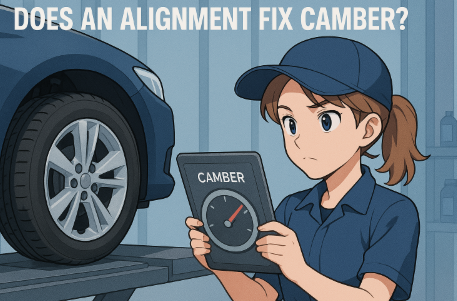If you’ve noticed your tires wearing unevenly or your car pulling to one side, you might be wondering:
“Does an alignment fix camber?”
The answer is: Yes—but only if your vehicle allows camber adjustment and the issue is within the adjustable range.
Let’s break it down so you understand exactly what camber is, how alignments work, and when a deeper fix might be needed.
What Is Camber?
Camber refers to the angle of your wheels when viewed from the front or back of the vehicle.
- Negative camber: Top of the wheel tilts inward
- Positive camber: Top of the wheel tilts outward
A little camber is normal and even beneficial for handling. But excessive camber, especially when uneven from side to side, can lead to:
- Uneven tire wear
- Poor traction or handling
- Vehicle pulling to one side
What Is a Wheel Alignment?
A wheel alignment is a service that adjusts the suspension angles to get your wheels pointing and sitting straight. A full alignment usually involves:
- Toe (direction the tires point)
- Camber (tilt in/out from vertical)
- Caster (steering axis tilt from the side view)
So, Does an Alignment Fix Camber?
✅ Yes, if Camber Is Adjustable
Many vehicles have factory camber adjustment bolts or slots, especially in the front suspension. During an alignment:
- The technician uses specialized tools and alignment machines
- Camber is adjusted to fall within manufacturer specs
- This helps prevent uneven wear and improves ride quality
❌ No, if Camber Is Out of Spec and Not Adjustable
Some cars and trucks don’t allow factory camber adjustments, or the suspension may be too far out of alignment due to:
- Worn or damaged components (like control arms, bushings, or ball joints)
- Accidents or curb impacts
- Lowered or lifted suspensions
In these cases, an alignment alone won’t fix the camber. You may need:
- Camber kits (aftermarket parts that allow camber adjustment)
- Suspension repairs or part replacements
How to Know If Camber Is the Issue
- Inside or outside edge tire wear
- Steering feels loose or “wandering”
- Visibly tilted wheels when viewed straight on
- Alignment shop printout shows camber out of spec
FAQs
Can camber be adjusted on all four wheels?
Only if your vehicle has independent suspension on all four wheels (common on newer vehicles). Many trucks and older cars only allow front camber adjustment.
How much camber is acceptable?
It varies by vehicle, but most cars aim for -0.5° to -1.5° camber. Excess beyond that can lead to rapid tire wear.
Does camber affect alignment?
Yes. Camber is one of the main alignment angles. Incorrect camber affects tire contact and should be corrected during alignment.
Final Thoughts
An alignment can fix camber—but only if your vehicle’s suspension allows it and the camber is not too far off. If your camber angle is outside adjustable limits or caused by worn parts, you’ll need to repair or upgrade components before a proper alignment can be done.
So if you’re dealing with camber issues, an alignment shop is the right first stop—they’ll tell you what can be adjusted and what might need replacing.










